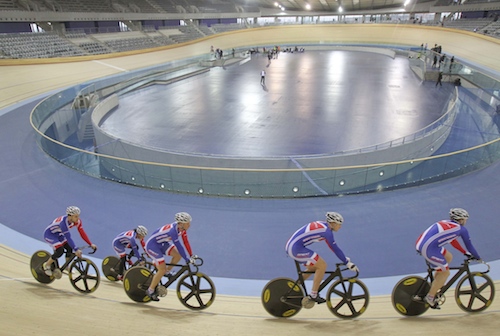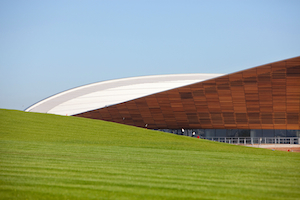Or search by topic
Number and algebra
Geometry and measure
Probability and statistics
Working mathematically
Advanced mathematics
For younger learners
Published 2013
How the Velodrome Found Its Form

Leaning into 2012
With its sweeping curved roof and beautiful cedar clad exterior the London 2012 Velodrome is a stunning building. But during the 2012 Olympic and Paralympic Games what athletes and spectators were most interested in was the curled ribbon of wooden track at its centre.
The Velodrome track was designed to produce world-record-beating times. The exact geometry of the track, designed by world famous track designer Ron Webb, is top secret. Like all velodromes, however, the track is sloped, from around 12 degrees on the relatively flat straights up to 42 degrees at the steepest part of the banked turns.
Seen from the centre, or looking down into the turns from the spectator seats, the banked turns seem perilously steep. But rather than tackling the slopes with caution cyclists use these steeply banked turns to create the high speeds necessary to fly around the track.
In order to move on a circular path you need an inward force, called the centripetal force, to pull you into the turn and stop you shooting off along a straight line.
If you have a mass m, a speed v and you are turning around a circle of radius r, then the centripetal force to move in this circular path at that speed is
Centripetal force = mv$^2$/r
We benefit from this force when we instinctively lean into a turn when riding a bike. The ground pushes against you at an angle, creating a vertical force to counteract gravity and a horizontal force from the friction stopping your angled wheel from sliding. This horizontal push provides the centripetal force that causes you to turn.
Now the faster your speed or the tighter the turn, the more you have to lean, but the friction of the track limits how far you can lean. If you go too fast or turn too tightly you'll lean so far over the wheel will skid out from beneath you and it's going to get messy.
This is why the track in the Velodrome is tilted: as the cyclists go into the turn their bikes can stay perpendicular to the track rather than relying on leaning over to get friction to pull them around. Cyclists can take the banked turns in the Velodrome at around 54km/h, speeds that would be impossible if the same curve were on a flat track.
Designing from the inside out
 Traditionally buildings were designed by thinking of their final form and making sure the building then suited its purposes. But the Velodrome was designed in the opposite way. Instead of starting from a final form the design team focussed on the
constraints placed on the building by its use as a velodrome.
Traditionally buildings were designed by thinking of their final form and making sure the building then suited its purposes. But the Velodrome was designed in the opposite way. Instead of starting from a final form the design team focussed on the
constraints placed on the building by its use as a velodrome.
"One of the key things in any sporting venue is basically how good the sight-lines are," says structural engineer Andrew Weir, one of the design team. "There are ways of measuring sight-lines, effectively what you see in a line from your eye over the head of the person below. Very steep terraces are very good, in that the person below is a lot further down. But there are access issues and you can
only have a certain staircase inclination."
To resolve all these constraints the design team used a computer aided design method called parametric modelling.
"With parametric modelling", explains Pete Winslow, another structural engineer on the design team, "you start off by saying, what are the rules that we need to apply?" The rules Winslow and his colleagues had to apply included safety issues like the seating pitch not being greater than a certain angle, and that every seat needs to have a sight-line onto the track. "And you can imagine there is a
whole bunch of rules you can build up from that. And then, there are only a small number of ways you can resolve all those rules at the same time, and that gives you your geometry."
So, rather than containing a fixed shape of the final building, the computer model contains the relationships between all the variables that constrain the final geometry. "What's good is you can cover a lot of ground very quickly with parametric design, to know if you're heading in the right direction", comments Weir.
Round and round
The track in the London Velodrome doesn't have the usual reflection symmetry you find in buildings. "If you folded the track in half lengthwise, the two halves wouldn't match," says Weir. The track does have rotational symmetry, it looks the same if you spin it by a half-turn. But the slope of the track going into and out of the turns is not the same. "This is simply because you always cycle the
same way around the track, and you go shallower into the turn and steeper out of it."
Although the difference in the banking going into and out of the turns is only fractional this does place constraints on the building. In particular the differences in height mean that the track is not symmetrical when you look at each end in isolation. "The difference in height means that the way we've arranged the seating [around the turns] isn't symmetrical. But obviously to make a building
efficient you want to get back to symmetries as much as possible. So just a couple of rows back from the front seat we've got back to symmetry."
Walls of sound
 The geometry of speed also inspired the curves of the sweeping roof and the cedar clad exterior of the Velodrome. The external shape of the building allows for seating around the whole of the track, creating, according to Olympic cycling
legend Chris Hoy, a “wall of noise” and a “gladiatorial atmosphere”.
The geometry of speed also inspired the curves of the sweeping roof and the cedar clad exterior of the Velodrome. The external shape of the building allows for seating around the whole of the track, creating, according to Olympic cycling
legend Chris Hoy, a “wall of noise” and a “gladiatorial atmosphere”.
Normally velodromes have very few, if any, seats at the ends of the track. “It's not a particularly good place to sit. The track is so steep you can't really look down and see what's going on in front of you,” says Andrew Weir. “And as the maximum rake of a seating tier is about 34 degrees that is going to get worse the more seats you put at the ends.”
But this concern for spectators also had to be balanced with the interests of the competing cyclists. “The feedback we had from the cyclists is that when they are going around a velodrome you get a lot of excitement on the straights but when you get to the ends it's almost like a deathly silence.” So the designers compromised; they included two rows of seats at each end, providing the “wall of
sound” the cyclists were looking for.
This is adapted from the articles "Leaning Into 2012" and "How the Velodrome Found its Form" by Rachel Thomas, based on an interview with Andrew Weir and Pete Winslow from Expedition Engineering, and published in Plus (plus.maths.org), the free online mathematics
magazine. Ӭ
Related Collections
You may also like
Designing Table Mats
Formulate and investigate a simple mathematical model for the design of a table mat.
Making Moiré Patterns
Moiré patterns are intriguing interference patterns. Create your own beautiful examples using LOGO!

